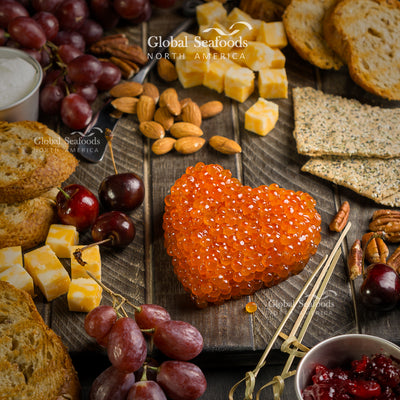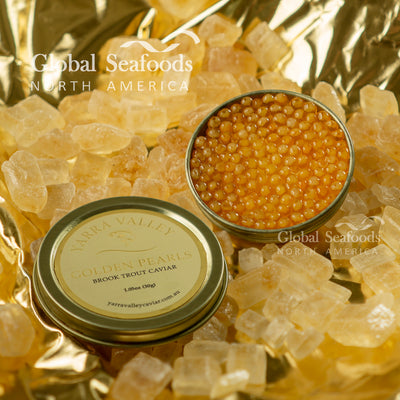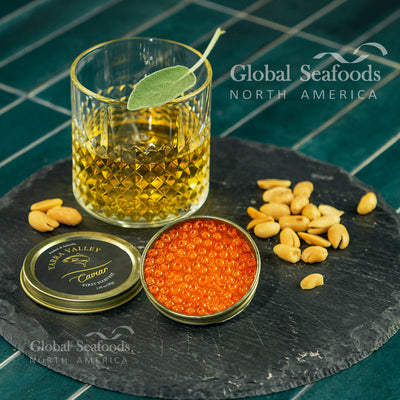🔥 The Rich History of IKURA Caviar – From Russia to Your Plate

The Rich History of IKURA Caviar: From Russia to Your Plate
IKURA caviar has long been a prized delicacy, enjoyed by royalty, connoisseurs, and food enthusiasts worldwide. From its origins in Russia to its modern-day popularity in Japan and beyond, this luxurious salmon roe has captivated taste buds for centuries.
In this blog post, we’ll explore the fascinating history of IKURA caviar, how it’s made, and the famous dishes that showcase its exquisite taste and texture.
📌 Looking for premium IKURA caviar?
🔗 Shop Global Seafoods’ Red Caviar Collection
1. The Origins of IKURA Caviar
Caviar has been a symbol of luxury and refinement for centuries, traditionally harvested from sturgeon in the Caspian and Black Seas. However, IKURA caviar (salmon roe) offers a unique alternative, bringing vibrant color, a distinct popping texture, and a rich umami flavor to the world of fine dining.
✔ The word "IKURA" comes from the Japanese language, meaning "salmon roe."
✔ Russia in the 16th century – The first records of salmon caviar being served to Russian royalty.
✔ 19th century – Russia establishes the first caviar farms, leading to widespread consumption in Europe and Asia.
✔ Early 20th century – IKURA caviar gains popularity in Japan, where it becomes a staple in sushi and donburi dishes.
✔ Today – IKURA caviar is enjoyed worldwide, from gourmet restaurants to home kitchens.
📌 Looking for sustainably sourced salmon roe?
🔗 Buy Chum Salmon Caviar
2. How IKURA Caviar is Made
IKURA caviar is harvested through a delicate process that ensures quality, flavor, and texture.
🔹 Steps in Making IKURA Caviar:
✔ Salmon roe is carefully extracted from wild or farmed salmon.
✔ Eggs are cleaned and separated to remove any impurities.
✔ Lightly salted to preserve freshness and enhance natural flavors.
✔ Packed in glass jars or vacuum-sealed containers for distribution.
📌 Want high-quality, fresh IKURA caviar?
🔗 Buy Coho Salmon Caviar
3. Famous Dishes Featuring IKURA Caviar
IKURA caviar is incredibly versatile, making it a luxurious addition to a variety of dishes.
🔹 1. Ikura Sushi
✔ A Japanese classic, featuring vinegared rice topped with a generous spoonful of IKURA caviar.
🔹 2. Ikura Donburi (Salmon Roe Rice Bowl)
✔ A simple yet flavorful dish consisting of steamed rice, IKURA, nori (seaweed), and wasabi.
🔹 3. Blini with IKURA Caviar
✔ A Russian delicacy, featuring thin pancakes topped with sour cream and IKURA caviar.
🔹 4. IKURA Caviar Pasta
✔ A modern gourmet dish, where IKURA is added to creamy pasta for a burst of umami flavor.
🔹 5. IKURA Caviar Canapés
✔ Elegant appetizers made with crackers, crème fraîche, and IKURA caviar—perfect for parties.
📌 Looking for vibrant, flavorful red caviar?
🔗 Buy Pink Salmon Caviar
4. The Health Benefits of IKURA Caviar
Beyond its luxurious appeal, IKURA caviar is also packed with essential nutrients.
✔ High in Omega-3 Fatty Acids – Supports heart health and brain function.
✔ Rich in Vitamin B12 – Essential for energy production and nerve health.
✔ Excellent Source of Vitamin D – Promotes strong bones and immune function.
✔ High-Quality Protein – A nutritious and delicious protein source.
📌 Want a nutrient-rich, delicious caviar?
🔗 Buy King Salmon Caviar
5. How to Store IKURA Caviar
To maintain its freshness and delicate texture, proper storage is crucial.
✔ Refrigerate at 28-32°F (-2 to 0°C).
✔ Keep it in original vacuum-sealed packaging.
✔ Once opened, consume within 5-10 days.
✔ Avoid storing near strong-smelling foods.
📌 Looking for long-lasting, premium caviar?
🔗 Buy Trout Red Caviar
6. Frequently Asked Questions (FAQs)
Q1: Is IKURA caviar sustainable?
✔ Yes, when sourced responsibly. Look for certified sustainable options.
📌 Shop responsibly sourced caviar:
🔗 Explore Global Seafoods’ Red Caviar Collection
Q2: How should IKURA caviar be served?
✔ Serve chilled on ice with blinis, toast, or sushi.
Q3: What makes IKURA caviar different from sturgeon caviar?
✔ IKURA comes from salmon, while traditional black caviar comes from sturgeon.
✔ IKURA has a milder, sweeter taste, while sturgeon caviar is more intense and briny.
📌 Looking for a milder, buttery alternative?
🔗 Buy Trout Caviar
7. Conclusion – The Timeless Appeal of IKURA Caviar
IKURA caviar has a rich history spanning centuries and continues to be one of the most beloved gourmet delicacies in the world. Whether enjoyed in traditional Russian dishes, modern Japanese cuisine, or as an elegant appetizer, its vibrant color, popping texture, and rich flavor make it an unforgettable culinary experience.
✔ Rooted in history, yet globally beloved.
✔ A versatile ingredient with incredible health benefits.
✔ Perfect for gourmet meals and celebrations.
📌 Want to experience the finest IKURA caviar?
🔗 Shop Global Seafoods’ Red Caviar Collection
📺 Watch seafood tutorials & caviar history on YouTube:
🔗 Global Seafoods YouTube Channel
Also in News

How to Make Sea Bream Sushi With Dry-Aged Tuna & Crab Roll — Step-by-Step With Chef Joshua
A complete guide to making Sea Bream sushi at home, including filleting, curing, slicing, and building a Dry-Aged Tuna & Crab sushi roll. Chef Joshua shares professional tips for restaurant-quality results.

Boiled Crab for Game Night: Everything You Need for a Perfect Seafood Party
Take your game night to the next level with a Boiled crab party. Learn the best recipes, cooking tips, and hosting hacks for a memorable seafood feast.

Boiled Crab for Date Night: A Romantic Guide to the Perfect Seafood Feast
Make your next date night unforgettable with a romantic Boiled crab experience. This guide covers everything you need to know, from ambiance to the best crab varieties.








